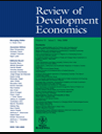
Abstract
A simple intertemporal expected-utility model for the household is developed to explore the determinants of split and family migration. Split migration occurs when the household head moves from a rural to an urban area first, and the rest of the family remains behind to join him later. Family migration occurs when the household moves together. The validity of the theoretical model is tested using data from Kenya. The findings support the predictions of the theoretical model; specifically, the results suggest that a large number of dependents may increase the likelihood of split migration.
Links
Resource collections
- UN Habitat - Urban Response Collection
- Urban Response - Urban Crisis Preparedness and Risk Reduction
- Urban Response Collection - Community Engagement and Social Cohesion
- Urban Response Collection - Economic Recovery
- Urban Response Collection - Environment and Climate Change
- Urban Response Collection - Housing, Land and Property
- Urban Response Collection - Urban Crisis Response, Recovery and Reconstruction
- Urban Response Collection - Urban Resilience